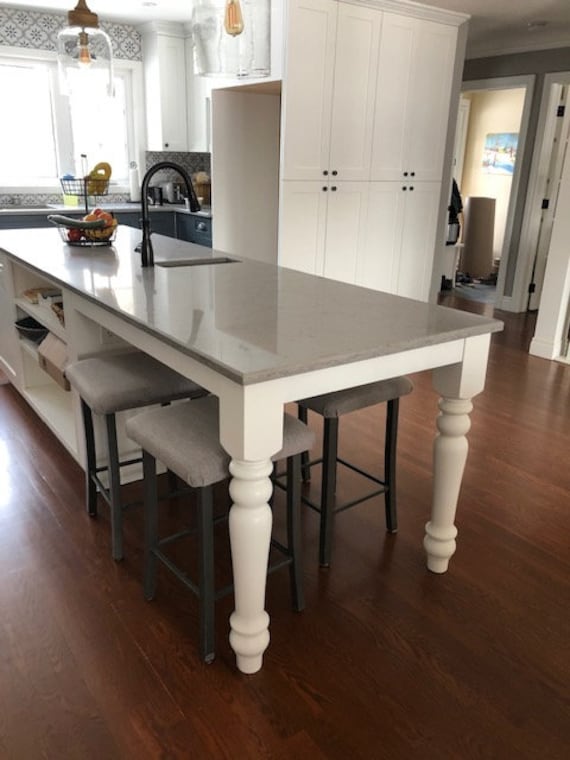Picking the Suitable Kitchen Island Leg for Sturdiness and Functionality
Wiki Article
The Relevance of a Sturdy Cooking Area Island Leg in Producing a Functional Cooking Location
A tough cooking area island leg serves as a basic element in establishing a functional food preparation atmosphere, supplying required support for both the kitchen counter and different cooking area tasks. As kitchen areas develop into multifunctional locations for cooking, dining, and mingling, the selection of products and design factors to consider for island legs ends up being increasingly vital.Advantages of Sturdy Island Legs
Offering necessary support, tough kitchen area island legs play a crucial role in boosting the performance and longevity of kitchen islands - kitchen island leg. These legs not only birth the weight of the kitchen counter and any kind of additional items put on the island, but additionally add to the general security of the framework. A well-supported kitchen area island makes sure that it remains upright and functional, also under heavy usage, which is specifically essential in busy kitchen area atmospheresFurthermore, strong island legs can enhance the aesthetic appeal of the kitchen area. They offer a solid structure that can complement numerous style styles, from contemporary to standard. This adaptability allows house owners to personalize their kitchen area islands according to personal preference while guaranteeing that the structural stability continues to be uncompromised.
In addition to their supportive role, durable kitchen area island legs can additionally enhance safety. Inevitably, investing in strong kitchen island legs is necessary for a functional and aesthetically pleasing cooking area.
Materials for Kitchen Area Island Legs
When choosing products for cooking area island legs, durability and aesthetic appeal are vital aspects to think about,. The most common materials consist of wood, steel, and engineered timber, each offering distinct benefits.Wood, such as cherry, maple, or oak, is a timeless choice due to its stamina and ageless appeal (kitchen island leg). It can withstand substantial weight and is immune to put on, making it excellent for high-use kitchen environments. Furthermore, wood can be tarnished or painted to complement numerous kitchen area styles
Steel legs, usually crafted from stainless steel or wrought iron, give a industrial and modern look. They are exceptionally solid and can support substantial tons while being immune to dampness and heat, which is advantageous in a cooking area. Steel legs can likewise be easily cleansed, improving their practicality.

Style Factors To Consider for Security
The option of materials for kitchen area island legs directly influences the style factors to consider for stability. When creating a kitchen area island, it is critical to examine the weight-bearing ability of the chosen products. Larger materials, such as strong timber or metal, normally provide greater security, specifically under the tension of day-to-day usage.In addition, the leg design should incorporate proper geometry to boost security. A larger base increases the support area, minimizing the threat of tipping or wobbling. Consideration must also be provided to the elevation of the legs; out of proportion leg sizes can lead to inequality, compromising the total stability of the island.
Furthermore, the circulation of weight across the island is critical. Guaranteeing that the leg positioning aligns with the heaviest parts, such as kitchen counters and devices, will certainly additionally enhance security.
Maintenance Tips for Long Life

Cleaning up is an additional important aspect of maintenance. Depending upon the product of the legs-- whether timber, metal, or composite-- ideal cleaning techniques ought to be employed. For wood legs, a mild clean with an appropriate timber and a wet fabric cleaner will certainly help maintain their coating. Steel legs may call for a light polish to prevent rust and keep their gloss.
Additionally, tightening screws and bolts regularly can make sure stability and stop wobbling. Consider strengthening the legs with extra brackets or sustains to enhance toughness if the cooking area island experiences hefty usage. Applying a protective finish or sealant can secure against dampness and discolorations, extending the lifespan of the legs. By following these maintenance suggestions, home owners can ensure their cooking area island legs continue to be practical and durable for several years to come.
Picking the Right Leg Design
Regular upkeep makes certain that cooking area island legs stay tough and functional, yet selecting the appropriate leg style is equally important for both looks and support. The option of leg style can Recommended Site dramatically influence the overall layout and harmony of your kitchen.
Performance is another essential element. Thicker legs or those with a strong base can sustain larger kitchen counters and devices, boosting the island's utility. On the other hand, slender legs may develop a ventilated look, ideal for lighter styles but possibly much less encouraging.
Verdict
In summary, the explanation significance of strong kitchen island legs can not be overemphasized in the creation of a functional food preparation area. These legs supply crucial assistance, boost stability, and contribute to the overall visual of the cooking area.A tough kitchen area island leg offers as a basic part in developing a practical food preparation setting, supplying essential support for both the kitchen counter and numerous kitchen area activities.Providing vital support, strong cooking area island legs play a critical role in improving the capability and resilience of kitchen islands. Eventually, spending in durable cooking area island legs is important for a practical and aesthetically pleasing cooking location.
Consideration must likewise be offered to the elevation of the legs; out of proportion leg lengths can lead to discrepancy, jeopardizing the total security of the island.
Wood legs supply heat and a classic appearance, best site while steel legs provide a industrial and contemporary feeling.
Report this wiki page